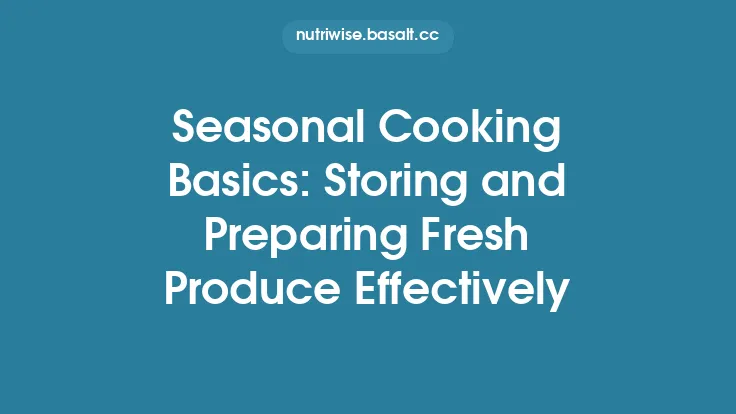Winter brings a stark shift in the availability of fresh produce, but for centuries cultures around the world have devised ingenious ways to preserve the bounty of the colder months while retaining as much of the original nutrition as possible. These time‑honored techniques—root cellaring, fermentation, drying, smoking, pickling, and ice‑house storage—are not only practical solutions to seasonal scarcity, they also embody a deep understanding of food chemistry, microbiology, and the natural rhythms of the environment. Below is a comprehensive guide to the most widely practiced traditional winter‑preservation methods, the science behind them, and practical tips for modern kitchens that wish to honor these age‑old traditions.
Root Cellaring and Cold‑Storage
What it is
Root cellars are insulated underground chambers that exploit the earth’s relatively stable temperature (typically 32–40 °F / 0–4 °C) and high humidity (85–95 %). By burying produce such as potatoes, carrots, turnips, parsnips, and winter squashes, families can keep these vegetables edible for months without any energy input.
Why it works
- Temperature stability slows enzymatic activity and respiration rates, reducing the consumption of stored sugars and vitamins.
- High humidity prevents desiccation, which would otherwise cause shrinkage and loss of water‑soluble nutrients (e.g., vitamin C).
- Low oxygen environments limit the growth of aerobic spoilage organisms, while still allowing the natural respiration of the vegetables.
Key practices
- Preparation – Trim excess foliage, but leave a few inches of stem on root vegetables to reduce moisture loss. Cure potatoes in a dark, well‑ventilated space for 1–2 weeks before storage to toughen their skins.
- Ventilation – Install a small vent or a simple pipe to allow excess moisture to escape, preventing mold.
- Layering – Place a layer of straw, sand, or sawdust at the bottom; this acts as a moisture buffer and provides a gentle cushion.
- Monitoring – Check humidity with a hygrometer and temperature with a simple thermometer. If humidity drops below 80 %, mist the walls lightly with water.
Nutrient retention
Studies show that root‑cellared carrots retain up to 90 % of their β‑carotene after six months, while potatoes lose only 10–15 % of their vitamin C, a far better outcome than refrigeration alone.
Fermentation
What it is
Fermentation harnesses beneficial microorganisms—primarily lactic acid bacteria (LAB) and yeasts—to transform raw vegetables into tangy, shelf‑stable foods such as sauerkraut, kimchi, and fermented turnip greens.
Why it works
- Acidification: LAB convert sugars into lactic acid, dropping the pH to 3.5–4.0, an environment hostile to pathogenic bacteria.
- Enzyme production: Microbial enzymes break down complex carbohydrates, making nutrients more bioavailable (e.g., increased levels of B‑vitamins and vitamin K₂).
- Probiotic benefits: Live cultures can survive passage through the gut, supporting a healthy microbiome.
Key practices
- Salt concentration – Use 2 %–3 % (by weight) non‑iodized salt to draw out water and create a brine that selects for LAB while inhibiting spoilage microbes.
- Submersion – Pack vegetables tightly in a fermentation vessel (ceramic crocks, glass jars, or food‑grade plastic) to keep them fully immersed. Use a weight or a fermentation airlock to maintain anaerobic conditions.
- Temperature control – Keep the fermenting batch at 55–68 °F (13–20 °C). Higher temperatures accelerate fermentation but can produce off‑flavors; lower temperatures slow the process, extending the development of complex flavors.
- Duration – Most vegetables reach a balanced flavor after 1–4 weeks. Taste testing is essential; once the desired tanginess is achieved, transfer to the refrigerator to slow further fermentation.
Nutrient retention
Fermentation can increase the bioavailability of minerals such as iron and calcium by up to 30 % due to the breakdown of phytates. Vitamin C, which is often lost during cooking, is largely preserved in raw fermented vegetables.
Air‑Drying and Sun‑Drying
What it is
Drying removes water, the primary medium for microbial growth, thereby extending shelf life. Traditional methods include hanging herbs and leafy greens in airy lofts, laying root vegetables on wooden racks, or sun‑drying thin slices of fruit and mushrooms.
Why it works
- Water activity (aw): Reducing aw below 0.6 halts most bacterial and fungal activity.
- Concentration of nutrients: As water evaporates, sugars, vitamins, and minerals become more concentrated per gram of product.
- Enzymatic slowdown: Low moisture limits enzymatic reactions that can degrade nutrients.
Key practices
- Pre‑treatment – Blanch leafy greens briefly (30–60 seconds) to inactivate enzymes that cause discoloration, then shock in ice water. For fruits, dip slices in a solution of ascorbic acid (1 % citric acid) to prevent oxidation.
- Spacing – Arrange pieces on screens or trays with at least 1 inch of space to allow airflow.
- Environment – Ideal drying rooms maintain 50–60 °F (10–15 °C) with 30–40 % relative humidity and good ventilation. Sun‑drying should be done on clean, elevated platforms, covered with fine mesh to keep insects out.
- Storage – Once fully dried (brittle, no pliable spots), store in airtight containers with a desiccant packet. Re‑hydrate by soaking in warm water before cooking.
Nutrient retention
Drying retains most fat‑soluble vitamins (A, D, E, K) and minerals. Water‑soluble vitamins, especially vitamin C, can degrade; however, rapid drying at low temperatures (e.g., using a solar dryer) can preserve up to 80 % of the original vitamin C content.
Smoking
What it is
Smoking exposes foods to wood smoke, which imparts flavor and introduces antimicrobial compounds such as phenols, formaldehyde, and organic acids. Traditional winter smoking is often applied to fish (e.g., herring, salmon), pork, and hardy greens.
Why it works
- Chemical preservation – Phenolic compounds act as antioxidants, slowing lipid oxidation.
- Partial dehydration – The heat removes surface moisture, reducing water activity.
- Microbial inhibition – Formaldehyde and other aldehydes in smoke are bacteriostatic.
Key practices
- Wood selection – Use hardwoods (apple, oak, hickory) for a balanced flavor; avoid resinous softwoods, which can produce unwanted toxins.
- Temperature control – Cold smoking (below 90 °F / 32 °C) preserves raw texture and is ideal for delicate fish; hot smoking (150–200 °F / 65–93 °C) both cooks and preserves.
- Duration – Light smoking (30 minutes to 2 hours) adds flavor; extended smoking (up to 12 hours) yields a firmer, longer‑lasting product.
- Post‑smoke storage – Cool the smoked item rapidly, then store in a refrigerated or root‑cellar environment. Vacuum‑sealing further extends shelf life.
Nutrient retention
Smoking retains most protein and mineral content. Omega‑3 fatty acids in fish are relatively stable under cold‑smoke conditions, though hot smoking can cause modest oxidation; using antioxidant‑rich wood (e.g., apple) mitigates this loss.
Pickling in Brine and Vinegar
What it is
Pickling preserves vegetables and fruits by submerging them in an acidic medium—either a salt‑based brine that ferments into lactic acid or a direct vinegar solution.
Why it works
- Acidic pH (≤4.6) inhibits most spoilage bacteria and molds.
- Osmotic pressure from salt draws out water, concentrating flavors and limiting microbial growth.
- Flavor development – Acids, sugars, and spices interact to create complex taste profiles that can enhance appetite during the monotony of winter meals.
Key practices
- Brine pickles – Use a 5 %–8 % salt solution; add spices (mustard seeds, dill, peppercorns) for flavor. Ferment at 60–70 °F (15–21 °C) for 1–3 weeks before refrigeration.
- Vinegar pickles – Combine distilled white vinegar (5 % acidity) with water, sugar, and salt in a 1:1 ratio; heat to dissolve solids, then pour over sterilized jars of prepared vegetables. Seal and process in a boiling water bath for 10–15 minutes.
- Safety – Ensure jars are properly sterilized and sealed; check seals after cooling. Any jar that fails the “pop” test should be refrigerated and consumed within a week.
- Storage – Brine‑fermented pickles keep for 6–12 months in a cool, dark pantry; vinegar pickles last up to a year unopened, and several months once opened if refrigerated.
Nutrient retention
Pickling preserves most minerals and fiber. Vitamin C loss is modest (10–20 %) in brine fermentation due to the acidic environment; vinegar pickles retain more vitamin C because the rapid acidification halts oxidative degradation.
Ice‑House and Snow Storage
What it is
Before modern refrigeration, many northern cultures built ice houses—insulated chambers packed with ice harvested from frozen lakes or stored snow—to keep perishable foods cool throughout winter.
Why it works
- Latent heat of fusion – Ice absorbs heat as it melts, maintaining a near‑freezing environment (32 °F / 0 °C) for weeks or months.
- Insulation – Thick walls of earth, straw, or sawdust slow heat transfer, extending the life of the ice.
Key practices
- Ice harvesting – Cut blocks of clear, bubble‑free ice in late winter; store them in sawdust or straw to reduce melt rate.
- Layering – Place a layer of ice at the bottom of the storage pit, then stack food items (e.g., dairy, meat, fresh berries) on top, covering each layer with more insulating material.
- Ventilation – Small vents allow warm air to escape while preventing condensation that could cause sogginess.
- Maintenance – Replace melted ice with fresh blocks periodically; monitor for any signs of thawing that could lead to spoilage.
Nutrient retention
Ice‑house storage essentially freezes foods, preserving nutrients at levels comparable to modern freezing. Vitamin C and B‑vitamin losses are minimal (<5 %) when foods are kept at stable sub‑freezing temperatures.
Integrating Traditional Methods into Modern Kitchens
While the above techniques have deep cultural roots, they can be adapted to contemporary homes with minimal investment:
- DIY root cellar – Convert a basement corner or a large cooler with a hygrometer and a small humidifier.
- Fermentation kits – Use food‑grade plastic containers with airlock lids; many online guides provide starter cultures for specific vegetables.
- Dehydrators – Electric dehydrators mimic sun‑drying but allow precise temperature control (115–135 °F / 46–57 °C) to protect heat‑sensitive nutrients.
- Smoking guns – Small handheld smokers can impart smoky flavor without the need for a full smokehouse, ideal for quick preservation of herbs or cheese.
- Vacuum sealers – Pair with any of the above methods to extend shelf life by reducing oxygen exposure.
Health Benefits of Preserved Winter Foods
- Consistent nutrient intake – By preserving peak‑season produce, families avoid the nutrient gaps that can occur when fresh options are scarce.
- Enhanced digestibility – Fermentation and mild cooking (e.g., smoking) break down complex fibers, making minerals more absorbable.
- Probiotic support – Regular consumption of fermented foods contributes to a diverse gut microbiome, linked to improved immunity—particularly valuable during the cold‑and‑flu season.
- Reduced food waste – Traditional preservation transforms surplus harvests into usable food, aligning with sustainable practices and lowering household food costs.
Practical Checklist for a Winter Preservation Routine
| Task | Frequency | Tools Needed | Key Tips |
|---|---|---|---|
| Root cellar inspection | Monthly | Thermometer, hygrometer, straw/sawdust | Rotate produce; remove any that show soft spots. |
| Fermentation batch start | As needed (seasonal) | Large glass jar, weight, airlock | Keep salt at 2–3 %; taste weekly. |
| Drying herbs/veg | Weekly (as harvested) | Mesh trays, low‑heat oven or dehydrator | Store dried herbs in dark glass jars. |
| Smoking fish/meat | Quarterly | Smoker or grill, hardwood chips | Cool smoked items quickly; vacuum‑seal. |
| Pickling | Bi‑annual (large batches) | Mason jars, boiling water bath | Sterilize jars; label with date. |
| Ice‑house maintenance (if applicable) | Seasonal | Sawdust, ice blocks, insulated container | Replace melted ice promptly. |
Closing Thoughts
Winter preservation is more than a set of culinary tricks; it is a cultural legacy that reflects humanity’s ingenuity in confronting seasonal scarcity. By understanding the underlying science—how temperature, humidity, acidity, and microbial activity interact—we can apply these age‑old methods with confidence, ensuring that the nutritional richness of the harvest endures throughout the cold months. Whether you are a home gardener, a culinary enthusiast, or simply someone seeking to eat more sustainably, embracing these traditional techniques offers a tangible connection to the past while delivering fresh, nutrient‑dense foods when the world outside is blanketed in snow.





